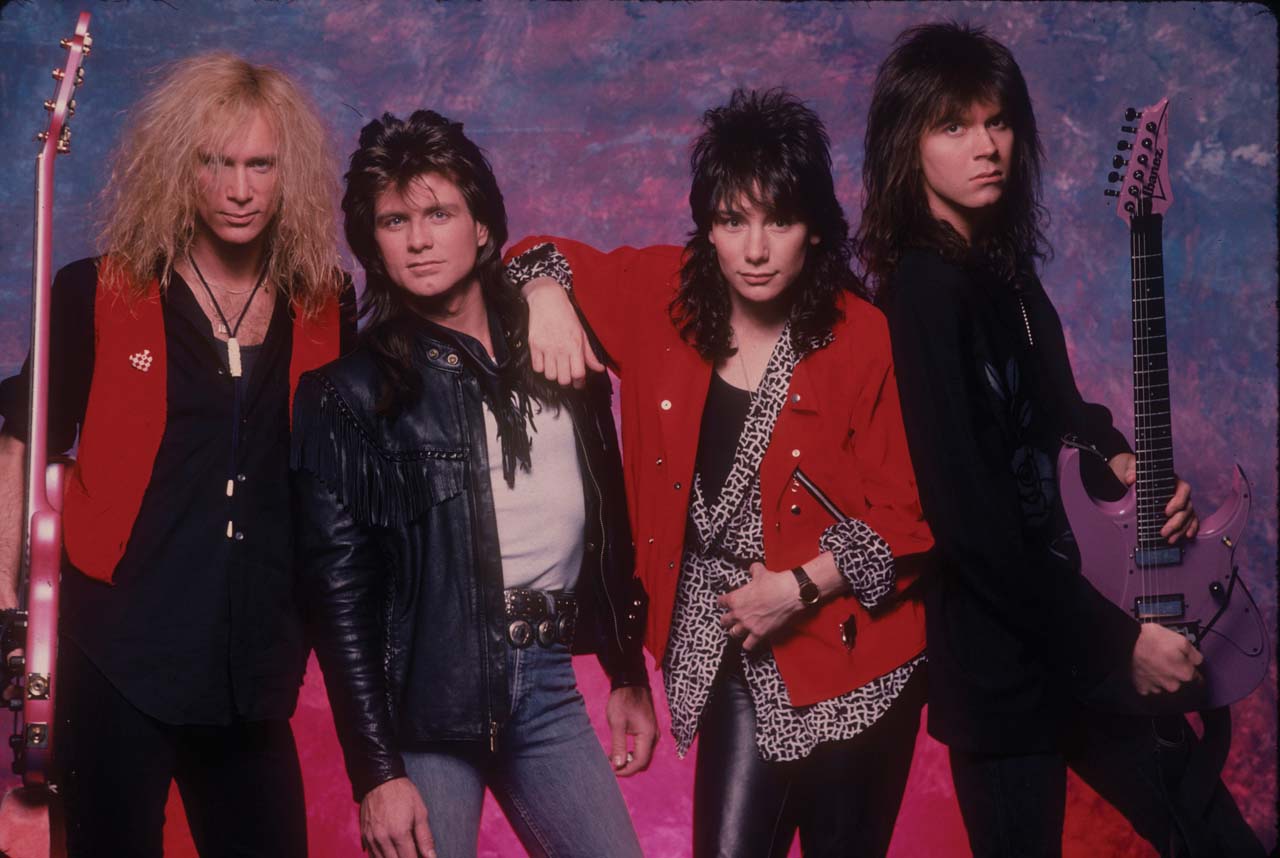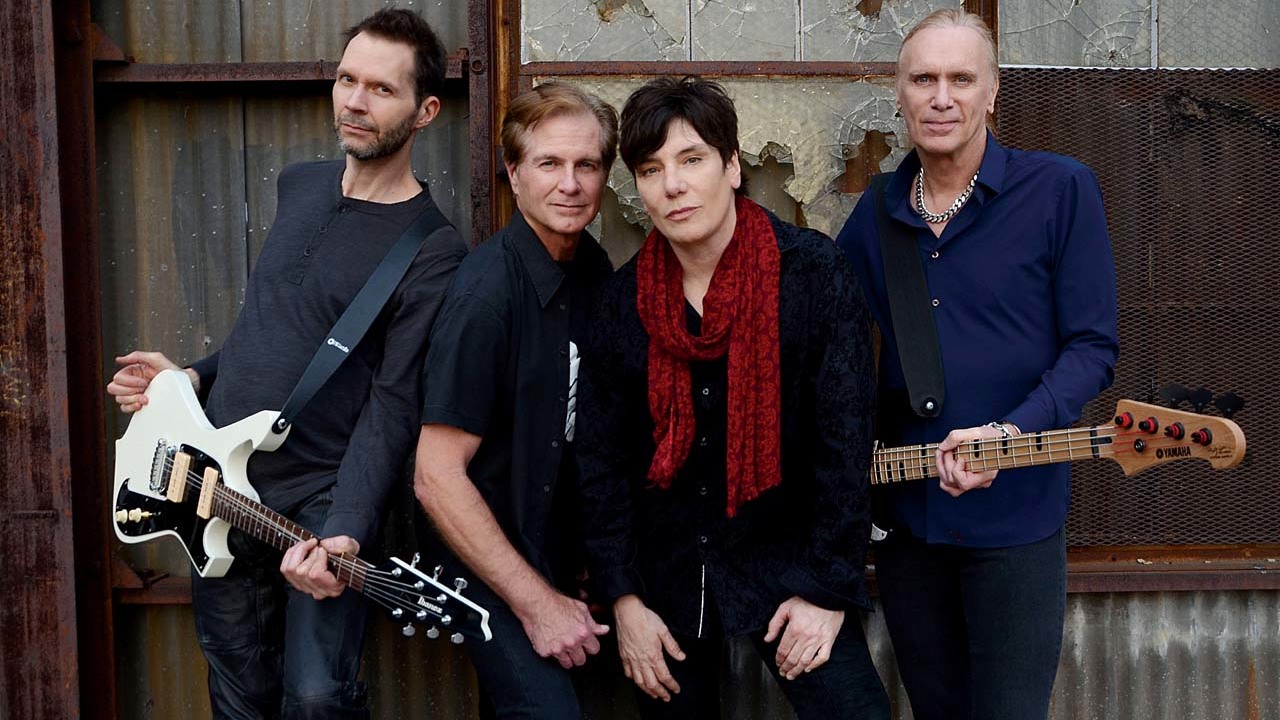That’s kind of a touchy subject,” says Mr. Big frontman Eric Martin, just as the band’s tour bus pulls into Nashville. “What are you trying to get at? Are you trying to break up the band?”
He’s responding to questions about what happened to the band following their Addicted To That Rush/Colorado Bulldog heyday and the colossal worldwide success they enjoyed with the ballad single To Be With You, having split 15 years ago. Did they struggle to sustain it? Was it tough accommodating virtuoso shredding and anthemic balladry in one unit? Were those stylistic extremes reflected by a fractious intra-band dynamic?
Mr. Big were a supergroup of sorts, who came together towards the end of the 80s. Martin was a cute-looking kid with a powerful, soulful vocal rasp. He had enjoyed some local notoriety as the singer with Bay Area band 415. Rebranded the Eric Martin Band, in 1983 they released Sucker For A Pretty Face, a decent album of melodic hard rock produced by Journey’s producer Kevin Elson. Martin followed that with an even better self‑titled solo album.
There was pressure to capitalise on that voice and those looks from his record company, who wanted him to be the next Michael Bolton, but he had more serious rock plans. He was invited to audition for both Toto and Van Halen, but the former deemed him “too green” and Martin “chicken-shitted out” at the eleventh hour.
Before being in Mr. Big, Pat Torpey was a well-respected drummer who had played with Belinda Carlisle and The Knack; guitarist Paul Gilbert had achieved some renown for his super-fast playing with LA metal band Racer X; and Billy Sheehan, a frequent winner of Best Rock Bassist polls, had been a member of power trio Talas and the David Lee Roth band.
“Yeah, we all had a past,” drawls Sheehan, the eldest of the four, in a hotel room in Connecticut three nights earlier. “I’m just not sure how successful they were. Racer X was a legendary local LA band but they never really got anywhere, Eric had three major record deals that went nowhere, and Pat ended up being kind of a sideman. I came in from the double-platinum David Lee Roth, with number-one videos and covers of magazines.”
If this sounds like hubris, it’s not meant to. Rather, Sheehan wanted the others to enjoy similar success to him. “I wanted to see them get exactly what I had and more, because they’re so talented. It turns out they did pretty good for themselves.”
According to Sheehan, there was no jostling for position when Mr. Big formed, with him as the main man. Nevertheless, Martin couldn’t help being star-struck. “I didn’t know how big Billy was until we walked into Warner Brothers,” he remembers, “and [producer] Ted Templeman and others would stop what they were doing: [enthusiastic greeting] ‘Billy!’ I’m like: ‘Holy shit!’ He was the ‘it’ boy, the god of bass players.”
Mr. Big had all the talent in place. All they needed was a place, a niche, to put it. Their eponymous debut album, released in 1989, wasn’t glam metal (which was about to be supplanted by grunge anyway), it was melodic hard rock with dazzling shredding, soulful vocals and plenty of harmonising that came from a shared love of Crosby Stills Nash & Young and Three Dog Night. “We were like Rush with Otis Redding on vocals,” Martin suggests.
“The one band we all agreed on was Free,” he adds (Mr. Big was a track on Free’s 1970 album Fire And Water). “When I heard Paul Gilbert play I got scared, because I didn’t want to be in a Racer X kind of band, I wanted to be in a more melodic hard rock band. I was always pushing for more melody.”
Their debut album, recorded in eight days with Kevin Elson at the controls, stalled at No.46, despite containing such Mr. Big favourites as Addicted To That Rush, Rock & Roll Over and Anything For You, the latter a sign of ballads to come.
“I was kinda bummed,” Martin admits of the record’s failure to really take off. “We worked so hard on it. It’s just that the public wasn’t going for it at the time of the Poisons and Mötley Crües.”
Martin considered his coiffed contemporaries “a great shtick and colourful novelty”, compared to whom Mr. Big looked dowdy in their jeans, T-shirts and jackboots. “We didn’t have stylists or make‑up, we had long hair from high school. We were unique. But nobody was getting it.”
“Those bands didn’t like us,” Sheehan says of his preening, big-hair peers. “They didn’t communicate with us or mention us in articles. Why? Cos we could play! There’s nothing wrong with style over substance, but we just happened to be more substance than style. We didn’t consciously puff our hair up or down to make a point.”
Despite coming out in grunge’s year zero, their second album, Lean Into It (1991), found Mr. Big in commercial favour. It reached No.15 and spawned hit singles with the psych-tinged Green-Tinted Sixties Mind and ballads Just Take My Heart and the enormous To Be With You, which went to No.1 in 15 countries. Suddenly the band, “workhorses for so long”, as Martin puts it, were all over radio and TV.
“It was like going from black and white to colour,” he says. “It was a wonderful time. We were travelling all over the world. Huge rock stars would come up to me. I remember one time in Barcelona, supporting Aerosmith, Steven Tyler putting his hands on me, going: ‘Hey, you’re a star!’”
Unlike many around them, they managed to not let fame and acclaim go to their heads, and also steered clear of the temptations that come with it.
“There were no drugs around at all,” says Sheehan, a follower of Scientology, although he insists he “wouldn’t want to get involved in a philosophy that had strict rules of how you live”. “Pat and Paul would rarely, if ever, drink. Myself and Eric would enjoy a beer or wine. But nobody had any alcohol or substance issues at all, ever. We were just four regular guys wanting to make music.”
They do admit to some womanising in some quarters, however. “We all lived vicariously through Billy Sheehan’s fun sexual exploits,” Martin says, laughing, but on the whole they were “pretty clean-cut kids”.
“We just wanted to rock,” says the singer, who had a revelatory encounter with bona fide hellraisers when Mr. Big met Skid Row. “We were all telling rock road stories. And Billy’s such a great speaker, but these guys with their hedonistic shittin’ and pissin’ on things and people… We were kinda freaked out.”

Mr. Big failed to maintain the phenomenal success that To Be With You in particular brought them, although they were, and remain, massive in Japan and Asia. By 1997, following the 90s albums Bump Ahead and Hey Man, Paul Gilbert decided to quit.
“He’s never said it, but I know he left because of me and Billy butting heads all the time,” Martin reveals. “He was like: ‘I can’t handle this shit any more.’ That took the wind out of our sails a lot. But me and Billy were never on the same page, maybe cos we weren’t riding the wave like we were with Lean Into It. He was a very strong personality, and there was me with my big mouth.”
With Richie Kotzen in place of Gilbert, the band recorded two albums – Get Over It (1999) and Actual Size (2001) – that gave Mr. Big “more of an AOR/FM radio kind of sound” according to Martin. It was a shift that didn’t go down too well with Sheehan – watch the video for the single Shine for evidence of what Martin calls “an unhappy rock’n’roll guy”.
“He hated that song,” Martin says. “A couple of times I’d ask: ‘Are you mad at me?’ and he’d say: ‘No, I just don’t like what we’re doing.’ I actually don’t think he liked me much back in the day.”
According to an interview Sheehan did in 2005, it was Martin’s constant sniping at his bass playing that was to blame for the bad atmosphere within the band. Martin, suspicious of Classic Rock’s motives in asking about that (“Are you trying to break us up?), denies being critical, but admits to some “stupid arguments” over volume (“Sorry, but I didn’t want to lose my hearing”). There was nothing that could be described as violent – the only actual physical altercation between members of Mr. Big came in their early days when drummer Torpey got Martin in a chokehold because he was being, in the drummer’s words, “a total jerk” – but clearly enough was enough.
“I think it just ran its course,” Martin decides of their original run. “I went through two wives, lost my parents and a bunch of dogs… I think we beat that horse to death. It was time to take a break.”

Sheehan is sanguine about the band split in 2002. “When you’re together with the same people in the same room for a long time, it starts to wear you down,” he muses. “We should have maybe just taken a break. Instead we let it fall apart.”
On February 1, 2009, Mr. Big announced on a Japanese radio station the reunion of the original line-up to celebrate the twentieth anniversary of their debut album, and that they would be touring and also recording a new album.
“People would constantly say: ‘Why don’t you get back together with Mr. Big?’ After seven years of being tormented with that incessantly, we said maybe we should get back together again,” Sheehan explains. “And I’m glad we did. All of us have evolved and matured, personally and musically, and we’re actually enjoying this very much.”
He sounds surprised. Did they have to do any apologising when they got back together?
“No, we just let it all go,” he says. “We ignored the whole thing. That was then, this is now. ‘Who cares?’ That was everybody’s point of view.
“We’re cool now,” he stresses. “We know how to deal with each other. I’m always really sad when I hear a band I like are at each other’s throats and they stay in different hotels and travel on different buses. We’re all together and it’s actually pretty cool. At Mr. Big’s worst, somebody gave somebody a dirty look. That’s as bad as it ever got, quite frankly.”
Since re-forming, there have been the albums What If…(2010), … The Stories We Could Tell (2014) and in July this year, Defying Gravity. On the latter, with Pat Torpey now suffering from Parkinson’s, he was assisted on drums by the band’s touring drummer Matt Starr. That setback aside, Martin and Sheehan both agree that Mr. Big are in a good place right now.
“There are a lot of sore muscles, but there are no monkeys on our back, we don’t have a record company telling us what to do all the time, and everything is painless and stress-free,” Martin says. “It’s easier to deal with, and that makes us happier to be with each other.”
Looking back at the global hits and big shows, such as opening for Aerosmith at Wembley Arena, is there a high point from those days?
“It’s kind of a high point now,” Sheehan contends. “We’re still here, we’re still alive and we still have people coming to our shows. I’m really pleased to be playing with these guys and have them as my friends. It’s a happy ending.”
Defying Gravity is out now via Frontiers Music.

